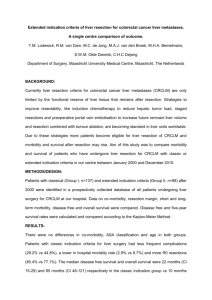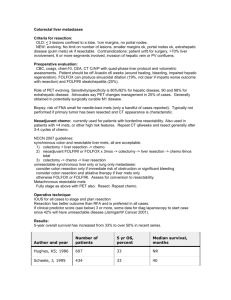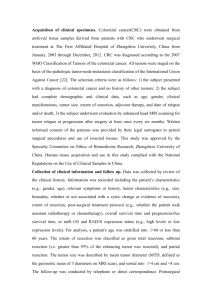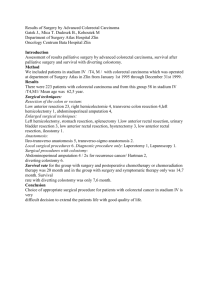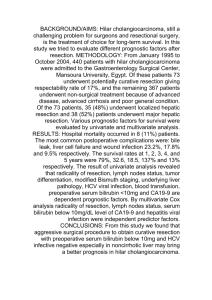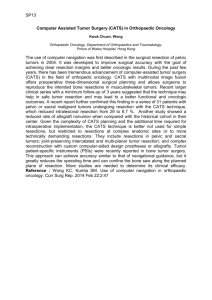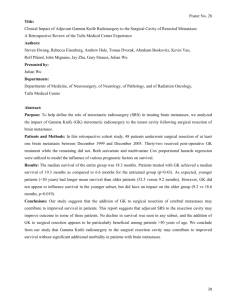Digestive Diseases and Sciences © Springer Science+Business
advertisement
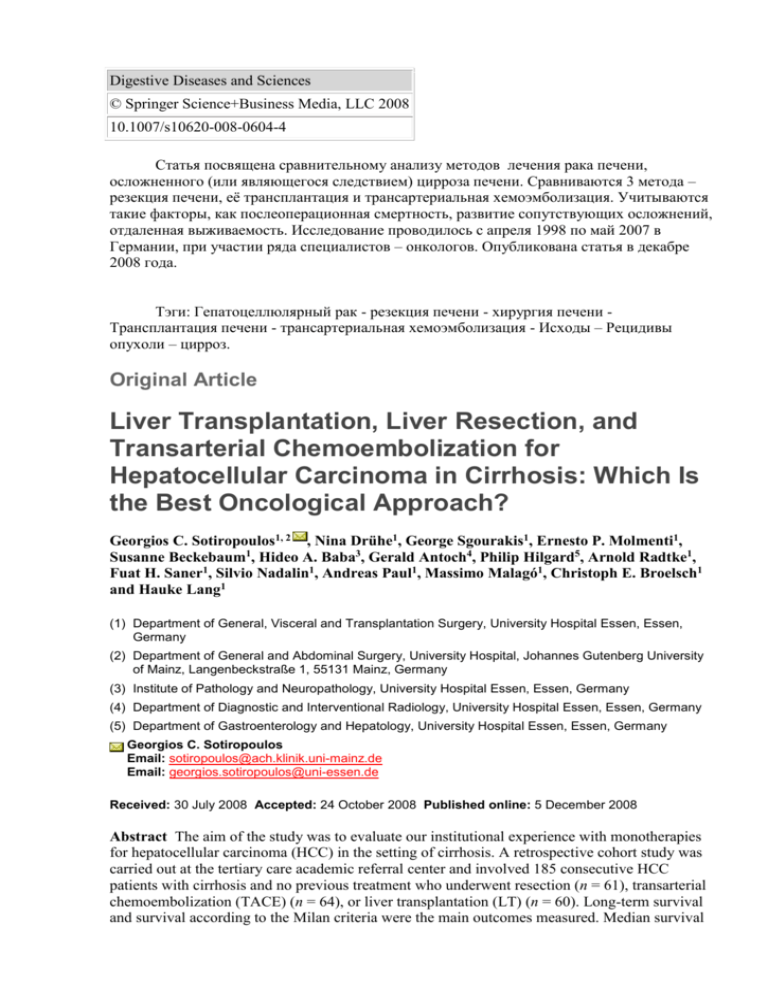
Digestive Diseases and Sciences © Springer Science+Business Media, LLC 2008 10.1007/s10620-008-0604-4 Статья посвящена сравнительному анализу методов лечения рака печени, осложненного (или являющегося следствием) цирроза печени. Сравниваются 3 метода – резекция печени, её трансплантация и трансартериальная хемоэмболизация. Учитываются такие факторы, как послеоперационная смертность, развитие сопутствующих осложнений, отдаленная выживаемость. Исследование проводилось с апреля 1998 по май 2007 в Германии, при участии ряда специалистов – онкологов. Опубликована статья в декабре 2008 года. Тэги: Гепатоцеллюлярный рак - резекция печени - хирургия печени Трансплантация печени - трансартериальная хемоэмболизация - Исходы – Рецидивы опухоли – цирроз. Original Article Liver Transplantation, Liver Resection, and Transarterial Chemoembolization for Hepatocellular Carcinoma in Cirrhosis: Which Is the Best Oncological Approach? Georgios C. Sotiropoulos1, 2 , Nina Drühe1, George Sgourakis1, Ernesto P. Molmenti1, Susanne Beckebaum1, Hideo A. Baba3, Gerald Antoch4, Philip Hilgard5, Arnold Radtke1, Fuat H. Saner1, Silvio Nadalin1, Andreas Paul1, Massimo Malagó1, Christoph E. Broelsch1 and Hauke Lang1 (1) Department of General, Visceral and Transplantation Surgery, University Hospital Essen, Essen, Germany (2) Department of General and Abdominal Surgery, University Hospital, Johannes Gutenberg University of Mainz, Langenbeckstraße 1, 55131 Mainz, Germany (3) Institute of Pathology and Neuropathology, University Hospital Essen, Essen, Germany (4) Department of Diagnostic and Interventional Radiology, University Hospital Essen, Essen, Germany (5) Department of Gastroenterology and Hepatology, University Hospital Essen, Essen, Germany Georgios C. Sotiropoulos Email: sotiropoulos@ach.klinik.uni-mainz.de Email: georgios.sotiropoulos@uni-essen.de Received: 30 July 2008 Accepted: 24 October 2008 Published online: 5 December 2008 Abstract The aim of the study was to evaluate our institutional experience with monotherapies for hepatocellular carcinoma (HCC) in the setting of cirrhosis. A retrospective cohort study was carried out at the tertiary care academic referral center and involved 185 consecutive HCC patients with cirrhosis and no previous treatment who underwent resection (n = 61), transarterial chemoembolization (TACE) (n = 64), or liver transplantation (LT) (n = 60). Long-term survival and survival according to the Milan criteria were the main outcomes measured. Median survival after resection, TACE, and LT was 11, 14, and 23 months, respectively. Five-year cumulative survival after resection, TACE, and LT was 23, 10, and 59%, respectively (P = 0.001). Five-year cumulative disease-free survival after resection and LT was 15% and 77%, respectively (P = 0.002). The presence of complications in the resection group (P = 0.004), MELD score (P = 0.0003), and maximum tumor diameter (P = 0.05) in the TACE group, and tumor grade (P = 0.01) and complications (P = 0.004) in the LT group were found to be independent predictors of survival. Five-year survival for patients within the Milan criteria after resection, TACE, and LT was 26, 37, and 66%, respectively. Five-year survival for patients outside the Milan criteria for patients undergoing LT was 53%. The results suggest that LT represents the best oncological treatment option for patients with HCC in the setting of cirrhosis, even for those beyond the Milan criteria. Considering the scarcity of available organs, liver resection remains the best alternative option. TACE remains a potential therapy in patients within the Milan criteria, where it may be more beneficial than resection. Keywords Hepatocellular carcinoma - Liver resection - Liver surgery - Liver transplantation Transarterial chemoembolization - Patient outcome - Tumor recurrence - Cirrhosis Abbreviations AFP Alpha fetoprotein - HBV Hepatitis B virus - HCC Hepatocellular carcinoma - HCV Hepatitis C virus - LT Liver transplantation - MELD Model for end-stage liver disease NS Not significant - TACE Transarterial chemoembolization - TNM Tumor Nodes Metastasis UICC Union International Contre le Cancer Introduction Hepatocellular carcinoma (HCC) is the third leading cause of cancer-related deaths worldwide, accounting for almost half a million annual deaths [1, 2]. Its incidence has increased dramatically in the US as a result of the current hepatitis C epidemic, and is expected to continue to do so over the next 2 decades [1, 3]. Hepatitis B virus, hepatitis C virus, and chronic heavy alcohol use leading to cirrhosis remain the most important predisposing factors [1–4]. Since HCC usually arises in the setting of cirrhosis, several treatment modalities have been developed to better address both pathologies, i.e., malignancy and end-stage liver disease. Surgical procedures, ablative treatments, and systematic therapies have been evaluated in both single- and multi-center trials. Liver resection, transarterial chemoembolization (TACE), and liver transplantation (LT) are the most popular options. Radiofrequency ablation represents another widely applied method in this task. However, because of the known discrepancies among radiological and pathological tumor findings regarding HCC in the end-stage cirrhotic liver [5] and our bad experience concerning treatment with RFA for HCC in cirrhosis, RFA was only sporadically performed in our institution for this indication. As a consequence, these sporadic data were not included for the purposes of this analysis. Although many studies have compared results in various combinations [6–27], little information is available on outcomes as monotherapies at a single center. The purpose of this study was to evaluate and compare long-term results after liver resection, TACE, and LT when implemented as monotherapies in patients with HCC and cirrhosis at a single European tertiary hepatobiliary specialty center. Patients and Methods Between April 1998 and May 2007, a total of 185 consecutive HCC patients with cirrhosis and no prior tumor treatments were admitted to our department. As per our protocol, the standard initial evaluation addressed the exclusion of extrahepatic liver disease and operability/operative risk. Criteria for partial hepatectomy included anatomically resectable disease and adequate reserve liver function. In cases of end-stage liver disease, LT was discussed as a possible therapeutic option. Patients with live donors were evaluated on a case-by-case basis according to their age, severity of liver disease, alpha fetoprotein (AFP) levels, and HCC characteristics at the time of presentation. Milan criteria (single tumor ≤5 cm; two to three tumors, none of them >3 cm; no vascular invasion) [28] were not considered an absolute contraindication in cases of living donor LT [29]. TACE was considered for patients who did not qualify for liver resection, deceased or live donor LT, and was performed at our Institution or elsewhere. Portal vein thrombosis, arterio-portal fistula, extrahepatic disease, and decompensated liver cirrhosis were considered contraindications for TACE. Patients with prior tumor-specific treatments, bridging treatments prior to LT, and re-admission for HCC recurrence were excluded from the study. Preoperative diagnostic workup included abdominal ultrasound, computed tomography (CT) scan, and chest X-ray. All patients were followed up until 31 August 2007. Data were divided into three groups, according to the therapy received (group 1: liver resection; group 2: TACE; group 3: LT) and evaluated for (1) demographic and preoperative characteristics, (2) operative and intervention-related details, (3) morbidity and mortality, (4) pathologic findings, including number of tumors, tumor size, tumor stage, and grading, (5) outcome as determined by tumor recurrence and survival, and (6) analysis of prognostic factors for overall and disease-free survival. Statistical Analysis Statistical methods used included nonparametric Fisher’s exact test (one-tail) for categorical variables, Mann–Whitney U test for quantitative variables, and power analysis (one- and twosided) for sample size calculations. Life tables were constructed with the Kaplan–Meier product limit method. Gehan’s Wilcoxon test was employed to compare survival. Univariate and multivariable Cox proportional hazard regression analyses were used for predictors of morbidity and mortality. Significance was assigned at 0.05. Statistica release 7 (Statsoft) was used for statistical analysis. Results Demographic and Preoperative Characteristics There were 185 patients, of which 149 were males and 36 females (ratio 4.14:1). Median age was 62.4 years (range 17.7–80.5). The etiology of cirrhosis was hepatitis C virus (HCV) in 36% of cases, hepatitis B virus (HBV) in 17%, alcohol abuse in 21%, cryptogenic in 12%, steatohepatitis in 3%, HCV and alcohol abuse in 2%, HBV and HCV in 2%, and other causes or combinations in 7%. Median Model for End-Stage Liver Disease (MELD) score was 9 (range 2– 42). Sixty-two patients met the Milan criteria. The remaining 123 were beyond these criteria. Median AFP level was 19 ng/ml (range 1–64,200 ng/ml). Operative and Intervention-Related Details Sixty-one (n = 61) patients underwent liver resection, 64 TACE, and 60 LT. Among the resection group (n = 61), 20 underwent simple segmentectomies, 14 bisegmentectomies, 8 right hemihepatectomies, 5 left lateral sectionectomies, 5 left hemihepatectomies, 4 atypical resections, 3 trisegmentectomies, 1 right hemihepatectomy plus segment II excision, and 1 right hemihepatectomy plus caudate lobectomy. Among the TACE group (n = 64), 10 patients underwent 1 session, 15 patients 2 sessions, 5 patients 3 sessions, 8 patients 4 sessions, and 24 patients 5–14 sessions. Among the LT group (n = 60), 30 patients underwent living donor LT, 27 deceased donor LT, and 3 split graft LT. Median ICU and hospital stays for the resection, TACE, and LT groups were 1 and 16 days, 0 and 2 days, and 6 and 29 days, respectively. Morbidity and Mortality Morbidity rates for the resection, TACE, and LT groups were 38%, 11%, and 38%, respectively. Resection group complications included biliary leaks (n = 2), abdominal abscesses (n = 2), evisceration (n = 1), pulmonary failure (n = 2), multiorgan failure (n = 5), liver insufficiency (n = 9), massive ascites (n = 1), and peritonitis (n = 1). TACE complications included encephalopathy (n = 1), emesis (n = 1), fever (n = 1), super-infection of the ablated liver requiring CT guided drainage (n = 3), and extensive liver necrosis (n = 1). LT complications included encephalopathy (n = 1), bleeding/hematoma (n = 5), hepatic artery thrombosis (n = 4), bile leaks (n = 2), pulmonary embolism (n = 1), pancreatitis (n = 1), renal insufficiency (n = 1), poor primary function/small-for-size syndrome (n = 2), pneumonia (n = 2), central pontine myelinolysis (n = 2), and abscess (n = 1). Predictors of complications were defined by general linear models analyses of covariance. Age, MELD score, AFP levels, and tumor diameter constituted continuous variables. Extent of surgery in the resection group, number of sessions in the TACE group, deceased versus living donors in the transplantation group, UICC stage, tumor multifocality, and meeting/exceeding the Milan criteria constituted categorical variables. None of the above variables reached statistical significance as an independent predictor of complications by multivariate analysis (sigmarestricted parameterization). The corresponding model (Test of SS Whole Model versus SS Residual) was not able to predict complications in any of the three groups (resection group, P = 0.109; TACE group, P = 0.231; LT group, P = 0.740). Thirty-day mortality for the resection, TACE, and LT groups was 23%, 0%, and 8%, respectively. Fourteen resection group patients died within 30 postoperative days: 12 as a result of multiorgan failure, 1 because of aspiration pneumonia, and 1 because of a massive pulmonary embolism. There were five 30-day deaths in the LT group: two patients died secondary to multiorgan failure and one each as a result of massive pulmonary embolism, methicillin-resistant Staphylococcus aureus pneumonia and right ventricular failure. No early deaths were observed in the TACE group. One-tailed Fisher exact P test showed a significant difference in 30-day mortality among the resection and LT groups (P = 0.048). Pathology Median tumor diameter was 4 cm in the resection group (range 1–19 cm), 6 cm (range 3–14 cm) in the TACE group, and 4 cm (range 1–16 cm) in the LT group. HCCs were solitary in 101 (55%) patients (50 in group 1, 22 in group 2, and 29 in group 3). Multifocal tumors were encountered in 66% (n = 42) of TACE cases, 52% (n = 31) of LT instances, and 18% (n = 11) of resection patients. Union International Contre le Cancer (UICC) stages I, II, and >II were encountered in 66 (group 1 = 31, group 2 = 14, group 3 = 21), 50 (group 1 = 12, group 2 = 16, group 3 = 22), and 69 patients (group 1 = 18, group 2 = 34, group 3 = 17), respectively. Microscopic vascular invasion was detected in 17 patients from group 1 and 12 patients from group 3. Evaluation of tumor grading by pathology revealed moderately differentiated HCCs in about half of the cases in the resection and LT group (36/61 and 35/60, respectively). Tumor characteristics are depicted in Table 1. Table 1 Tumor characteristics Well Tumor grade Resection group TACEa group Transplantation group n = 61 n = 64 n = 60 12 15 Moderate 36 35 Poor 13 10 Multiple tumors Yes/No 11/50 42/22 31/29 Maximum tumor diameter (cm) Median 4 6 4 Range (1–19) (3–14) (1–16) I 31 14 21 II 12 16 22 IIIA 12 18 15 IIIB 0 3 2 IIIC 5 12 0 IV 1 1 0 Meeting 26 10 26 Exceeding 35 54 34 UICC stage Milan criteria Lymphatic invasion Yes/No 4/57 1/59 17/44 12/48 R0/R1/R2 46/7/8 60/0/0 Microvascular invasion Yes/No R-Class aAll data for the TACE group are based on clinical diagnostic workup Comparisons were made among the three groups by Kruskal-Wallis ANOVA and median test for the following parameters: gender (P = 0.0366; all comparisons significant), age (P = 0.0001; resection versus TACE = NS), MELD score (P = 0.0001; resection versus TACE = NS), AFP (P = 0.6769; all comparisons NS), etiology of cirrhosis [P = 0.0024; significant only TACE (HBV/HCV = 10/19) versus LTx (HBV/HCV = 17/30)], Milan criteria (P = 0.988; significant only for TACE versus resection and TACE versus LT), complications (P = 0.989; significant only TACE versus resection and TACE versus LT), ICU stay P = 0.0001 (all comparisons significant), and hospital stay P = 0.0001 (all comparisons significant). Survival and Recurrence Seventy-one (n = 71) patients are currently alive after a median follow-up of 15.3 months (range: 0.2–144). Twenty-one (n = 21) resection patients are alive, 14 without recurrence, in the resection group. Thirteen (n = 13) patients are alive, three without current evidence of vital tumor, in the TACE group. Thirty-seven (n = 37) recipients are alive, 35 without recurrence, in the LT group. Forty of 185 total patients (22%) were followed for more than 3 years. Five-year overall and recurrence-free survival rates for the entire series (n = 185 patients) were 29% and 32%, respectively (Fig. 1). Fig. 1 Overall (a) and recurrence-free (b) survival for the entire series (n = 185) Median survival after resection, TACE, and LT was 11 months (range: 0.2–67.4), 14 months (range: 1.2–143.9), and 23 months (range: 0.3–105), respectively. One, 3-, and 5-year cumulative survival rates after resection, TACE, and LT were 52, 43, 23%; 60, 13, 10%; and 78, 69, 59%, respectively (Table 2). LT recipients had significantly increased survival (Fig. 2) (P = 0.001). Survival differences among resection and TACE (P = 0.754) achieved statistical significance (P = 0.006) only when 30-day mortality was excluded. Table 2 Yearly cumulative proportion surviving for patients of the three groups Year Resection group TACE group LT group Cumulative proportion surviving (%) 1 51.66 59.67 78.37 2 47.83 24.24 71.84 3 43.17 13.46 68.72 4 32.03 10.47 68.72 5 22.87 10.47 58.54 Cumulative proportion disease-free surviving (%) 1 72.97 – 89.79 2 55.80 – 84.18 3 49.60 – 84.18 4 40.33 – 84.18 5 14.66 – 77.44 Fig. 2 Cumulative proportion surviving (Kaplan–Meier curves) by groups Median disease-free survival for the resection and LT groups was 15.5 months (range: 0.2–67.4) and 29 months (range: 0.3–105), respectively. TACE patients were considered to have remnant tumor since no pathological evidence of clear margins or complete tumor necrosis could be produced. One, 3-, and 5-year cumulative disease-free survival among resection and LT patients was 73%, 50%, 15% and 90%, 84%, 77%, respectively (Table 2). There was a significant difference (Fig. 3) favoring the LT group (P = 0.002). Fig. 3 Cumulative proportion of disease-free surviving (Kaplan–Meier curves) for the resection and transplantation groups Analysis of Prognostic Factors for Overall and Disease-Free Survival We performed a univariate analysis for each group, taking into account age, gender, MELD score, AFP, cause of cirrhosis, tumor grade, lymphatic invasion, microvascular invasion, resection margin status, UICC stage, tumor multifocality, maximum tumor diameter, meeting or exceeding the Milan criteria, and postoperative complications. Resection margins status (P = 0.024), tumor multifocality (P = 0.012), and complications (P = 0.007) were significant predictors of survival in the resection group. MELD score (P = 0.0006), maximum tumor diameter (P = 0.05), and Milan criteria (P = 0.02) reached statistical significance for TACE. AFP level (P = 0.04), tumor grade (P = 0.007), lymphatic invasion (P = 0.05), tumor multifocality (P = 0.05), maximum tumor diameter (P = 0.023), Milan criteria (P = 0.048), and complications (P = 0.05) gained significance in cases of LT. A further multivariable analysis followed considering only predictors that reached significance in univariate analysis. The only independent predictor of survival in the resection group was the presence of complications (P = 0.004), MELD score (P = 0.0003), and maximum tumor diameter (P = 0.05) in the TACE group, and tumor grade (P = 0.01) and complications (P = 0.004) in the LT group. In order to document a difference in the 5-year survival rate among the resection group (23%), TACE group (10%), and LT group (59%), we applied a two-sided survival log-rank test under power analysis with a type I error (alpha) of 0.05 and a power of 0.95. Forty-one patients per treatment arm would be sufficient to detect a difference in survival rates among the three groups. This prerequisite is fully covered by our data. Discussion The management of patients with HCC in cirrhosis constitutes a matter of discussion and disputation among physicians all over the world [30–37]. The great variety of therapeutic options allows on the one side the search for the most convenient/cost effective therapy for each center, but on the other side, emphasizes the loss of the optimal option, which could be available and applicable in most cases [38–44]. However, some agreement was reached in the past years, i.e., that LT is recognized as the best therapy option for these patients under the presupposition that the HCC does not exceed certain pre-established criteria and the candidate has an acceptable surgical risk [28, 45–48]. The institution of this treatment modality, however, is limited by the current scarcity of organs that allows only for a limited number of candidates to be transplanted at specialized centers [49]. Our status as a combined hepatobiliary and transplant specialty center offering all potential treatment options allowed us to evaluate the three most frequently recommended treatments for HCC in the setting of cirrhosis, i.e., resection, TACE, and LT. Although data were prospectively recorded to our data base, this was not a prospective, randomized study, something difficult to perform in this special era of clinical medicine, since it is ethically very difficult to deny the LT opportunity to HCC patients otherwise eligible for transplantation. However, although the choice of the appropriate treatment followed an algorithm, i.e., firstly resection, secondly LT, and thirdly TACE being evaluated, resulting in some primary patient selection, statistical methods and data analysis from different points of view allow us to make some comparison and to discuss our results more deeply. Furthermore, power analysis of the data proved that the study volume was sufficiently large to detect significant differences among the three groups, having approximately 20 patients over the required minimum per arm. Independent predictors of survival by multivariable Cox proportional hazard regression analysis were the presence of complications in the resection group, MELD score, and maximum tumor diameter in the TACE group, and tumor grade and complications in the LT group. In a specific statistical study of the presence of postoperative/post-interventional complications among the three groups, none of the eight variables evaluated gained statistical significance as an independent predictor for the presence of complications. Even the extension of liver resection (hemihepatectomy versus segmentectomy in the resection group) or the transplant procedure (full-size deceased donor versus living donor LT in the LT group), although they gave the clinical feeling that they were combined with higher morbidity in cases of hemihepatectomy and living donor LT, respectively, were not characterized by statistically significant differences concerning the presence of complications. However, it is remarkable that the high morbidity of 38% in the resection group was followed by a correspondingly high 30-day mortality of 23%, although the correspondingly high morbidity of 38% in the LT group was combined with a lower 30-day mortality of 8%. The Milan criteria are the most applicable tool in evaluating treatment strategies for patients with HCC in cirrhosis. Evaluating our institutional experience with monotherapy for HCC in cirrhosis, 5-year survival was 44% for patients meeting the Milan criteria and 22% for patients exceeding them (P = 0.03524, Fig. 4). As most hepatobiliary/transplant centers have the policy to offer the possibility of transplant to HCC patients within these criteria, a further statistical analysis in our series was performed (Fig. 4), despite the fact that the Milan criteria did not gain significance as a predictor of patient survival in the multivariable model. This univariate analysis according to Gehan’s Wilcoxon test showed statistically improved survival for patients meeting the criteria only for the TACE (P = 0.04105) group and the LT (P = 0.03792) groups (P = 0.72 for the resection group). Five-year survival for patients within the Milan criteria was 26% for the resection group, 37% for the TACE group, and 66% for the LT group, respectively. There is an obvious survival benefit for HCC patients within the Milan criteria who undergo LT, and a simultaneous disadvantage for not transplanted HCC patients, who according to the Milan criteria could be eligible for LT, but because of other co-morbidities (age, poor physical and medical condition, high levels of AFP) and of the organ scarcity underwent resection or TACE. On the other hand, data analysis for patients outside the Milan criteria provides very interesting results. Four-year survival for patients outside the Milan criteria (no resection patient reached 5 years) was 30% for the resection group (for n = 35 patients), 7% for the TACE group (for n = 54 patients), and 53% for the LT group (for n = 34 patients), respectively. These apparent but politically very dangerous findings seem to imply that LT provides the best oncological longterm therapy for HCC patients, even for those beyond the currently recommended listing criteria! Of note is the fact that such cases beyond the Milan criteria are not open-ended, since for these three categories of monotherapy, a kind of patient selection is already performed, and patients with extrahepatic liver disease or macrovascular invasion are not considered. This observation is also explained by the fact that LT offers the chance for “cure” for both pathologies, i.e., malignancy and end-stage liver disease, whereas the role of liver resection and TACE is limited only to the oncological HCC pathology. Besides, performance of liver resection or TACE in the cirrhotic liver may further deteriorate the underlying liver function and diminish the long-term outcome. Fig. 4 Cumulative proportion of overall survival (Kaplan–Meier curves) according to the Milan criteria for the entire series (a), resection group (b), TACE group (c), and LT group (d) LT is undoubtedly the best treatment option for patients with HCC in cirrhosis. LT provides not only the best survival and recurrence-free rates, but it also represents the most “curative” option for these patients, since it provides the longest recurrence-free survival. In our series, the 5-year recurrence-free survival was as high as 77% after LT, compared to 20% after resection (P = 0.00236). The question that rises is about the alternative options, i.e., resection and TACE. In our series, there were no significant differences between resection and TACE groups for the parameters age, MELD score, AFP levels, and etiology of liver disease. Statistically significant differences were detected for the parameters presence of complications, ICU stay, hospital stay, and Milan criteria. Based on our data, 5-year survival for the resection and TACE groups was 23% and 10% (P = 0.754), respectively. Statistical significance was achieved only after the exclusion of 30-day mortality (P = 0.006). Hence, a more restrictive patient selection for the resection group could result in lower morbidity/30-day mortality rates and potentially in better long-term survival rates. From the transplant point of view, analysis of these data according to the Milan criteria give us 5-year survival rates for the resection and TACE group of 26 and 37% for patients within the criteria, respectively. Four-year survival rates were 30% for the resection group and 6% for the TACE group for patients outside the Milan criteria. Our findings suggest that patients with HCC and cirrhosis who are not candidates for LT could undergo TACE if their tumors are within the Milan criteria or liver resection if the lesions exceed them. In the case of patients within the Milan criteria, TACE provides local control with no exposure to operative morbidity/30-day mortality and avoids a rapid tumor recurrence in a regenerating precancerous cirrhotic liver. In the case of patients outside the Milan criteria, where local control is limited with TACE, resection could offer a survival benefit if the surgical morbidity/30-day mortality is improved. Contrary to these observations, liver resection constitutes the best treatment option in the instances of HCC in the non-cirrhotic liver [50–52], where the absence of cirrhosis is combined with a very different physical history of the disease. LT represents the best therapy option for patients with HCC in the setting of cirrhosis and in the absence of extrahepatic disease and/or macrovascular invasion, even for patients exceeding the Milan criteria. From the transplant point of view, restricted HCC criteria have to be applied for LT, given the scarcity of available organs in order to provide the same long-term outcomes as for patients transplanted for non-tumor indications. From the oncological point of view, HCC criteria have to be more liberal for LT, since LT itself provides the longest overall and recurrence-free survival to these patients. The best alternative seems to be liver resection, itself hampered by postoperative morbidity and mortality, at least in the western world. TACE, with a low rate of complications, remains an option especially in cases of cirrhotic patients within the Milan criteria. In such cases, it may even be superior to liver resection. References 1. Bosch FX, Ribes J, Díaz M, Cléries R. Primary liver cancer: worldwide incidence and trends. Gastroenterology. 2004;127(suppl 1(5)):S5–S16. doi:10.1053/j.gastro.2004.09.011. 2. Parikh S, Hyman D. Hepatocellular cancer: a guide for the internist. Am J Med. 2007;120(3):194–202. doi:10.1016/j.amjmed.2006.11.020. 3. El-Serag HB. Hepatocellular carcinoma: an epidemiologic view. J Clin Gastroenterol. 2002;35(suppl 2(5)):S72–S78. doi:10.1097/00004836-200211002-00002. 4. Motola-Kuba D, Zamora-Valdés D, Uribe M, Méndez-Sánchez N. Hepatocellular carcinoma. An overview. Ann Hepatol. 2006;5(1):16–24. 5. Sotiropoulos GC, Malago M, Momenti E, Paul A, Nadalin S, Brokalaki E. Liver transplantation for hepatocellular carcinoma in cirrhosis: is clinical tumor classification before transplantation realistic? Transplantation. 2005;79(4):483–487. doi:10.1097/01.TP.0000152801.82734.74. 6. Bruix J, Sherman M, Llovet JM, Beaugrand M, Lencioni R, Burroughs AK. Clinical management of hepatocellular carcinoma. Conclusions of the Barcelona EASL conference. European Association for the study of the liver. J Hepatol. 2001;35(3):421–430. doi:10.1016/S0168-8278(01)00130-1. 7. Llovet JM, Fuster J, Bruix J, Barcelona-Clínic Liver Cancer Group. The Barcelona approach: diagnosis, staging, and treatment of hepatocellular carcinoma. Liver Transpl. 2004;10(suppl 1(2)):S115–S120. doi:10.1002/lt.20034. 8. Fong Y, Sun RL, Jarnagin W, Blumgart LH. An analysis of 412 cases of hepatocellular carcinoma at a western center. Ann Surg. 1999;229(6):790–799. doi:10.1097/00000658-199906000-00005. 9. Bismuth H, Chiche L, Adam R, Castaing D, Diamond T, Dennison A. Liver resection versus transplantation for hepatocellular carcinoma in cirrhotic patients. Ann Surg. 1993;218(2):145–151. doi:10.1097/00000658-199308000-00005. 10. Michel J, Suc B, Montpeyroux F, et al. Liver resection or transplantation for hepatocellular carcinoma? Retrospective analysis of 215 patients with cirrhosis. J Hepatol. 1997;26(6):1274–1280. doi:10.1016/S0168-8278(97)80462-X. 11. Otto G, Heuschen U, Hofmann WJ, Krumm G, Hinz U, Herfarth C. Survival and recurrence after liver transplantation versus liver resection for hepatocellular carcinoma: a retrospective analysis. Ann Surg. 1998;227(3):424–432. doi:10.1097/00000658-199803000-00015. 12. Huang YH, Wu JC, Chau GY, et al. Supportive treatment, resection and transcatheter arterial chemoembolization in resectable hepatocellular carcinoma: an analysis of survival in 419 patients. Eur J Gastroenterol Hepatol. 1999;11(3):315–321. doi:10.1097/00042737-199903000-00017. 13. Figueras J, Jaurrieta E, Valls C, et al. Resection or transplantation for hepatocellular carcinoma in cirrhotic patients: outcomes based on indicated treatment strategy. J Am Coll Surg. 2000;190(5):580– 587. doi:10.1016/S1072-7515(00)00251-9. 14. Lee HS, Kim KM, Yoon JH, et al. Therapeutic efficacy of transcatheter arterial chemoembolization as compared with hepatic resection in hepatocellular carcinoma patients with compensated liver function in a hepatitis B virus-endemic area: a prospective cohort study. J Clin Oncol. 2002;20(22):4459–4465. doi:10.1200/JCO.2002.02.013. 15. Bigourdan JM, Jaeck D, Meyer N, et al. Small hepatocellular carcinoma in child A cirrhotic patients: hepatic resection versus transplantation. Liver Transpl. 2003;9(5):513–520. doi:10.1053/jlts.2003.50070. 16. Tang ZY, Zhou XD, Ma ZC, et al. Downstaging followed by resection plays a role in improving prognosis of unresectable hepatocellular carcinoma. Hepatobiliary Pancreat Dis Int. 2004;3(4):495– 498. 17. Yao FY, Kinkhabwala M, LaBerge JM, Bass NM, Brown R Jr, Kerlan R. The impact of pre-operative loco-regional therapy on outcome after liver transplantation for hepatocellular carcinoma. Am J Transplant. 2005;5(4 Pt1):795–804. doi:10.1111/j.1600-6143.2005.00750.x. 18. Sotiropoulos GC, Malago M, Molmenti E, et al. Efficacy of transarterial chemoembolization prior to liver transplantation for hepatocellular carcinoma as found in pathology. Hepatogastroenterology. 2005;52(62):329–332. 19. Majno PE, Sarasin FP, Mentha G, Hadengue A. Primary liver resection and salvage transplantation or primary liver transplantation in patients with single, small hepatocellular carcinoma and preserved liver function: an outcome-oriented decision analysis. Hepatology. 2000;31(4):899–906. doi:10.1053/he.2000.5763. 20. Adam R, Azoulay D, Castaing D, et al. Liver resection as a bridge to transplantation for hepatocellular carcinoma on cirrhosis: a reasonable strategy? Ann Surg. 2003;238(4):508–518. 21. Belghiti J, Cortes A, Abdalla EK, et al. Resection prior to liver transplantation for hepatocellular carcinoma. Ann Surg. 2003;238(6):885–892. doi:10.1097/01.sla.0000098621.74851.65. 22. Takano S, Watanabe Y, Ohishi H, et al. Multimodality treatment for patients with hepatocellular carcinoma: a single institution retrospective series. Eur J Surg Oncol. 2000;26(1):67–72. doi:10.1053/ejso.1999.0743. 23. Christians KK, Pitt HA, Rilling WS, et al. Hepatocellular carcinoma: multimodality management. Surgery. 2001;130(4):554–559. doi:10.1067/msy.2001.117106. 24. Medina-Franco H, Sellers MT, Eckhoff DE, Bynon JS, Urist MM, Heslin MJ. Multimodality treatment for patients with hepatocellular carcinoma: analysis of prognostic factors in a single Western institution series. J Gastrointest Surg. 2001;5(6):638–645. doi:10.1016/S1091-255X(01)80107-4. 25. Sotiropoulos GC, Lang H, Frilling A, et al. Resectability of hepatocellular carcinoma: evaluation of 333 consecutive cases at a single hepatobiliary specialty center and systematic review of the literature. Hepatogastroenterology. 2006;53(69):322–329. 26. Dharancy S, Boitard J, Decaens T, et al. Comparison of two techniques of transarterial chemoembolization before liver transplantation for hepatocellular carcinoma: a case-control study. Liver Transpl. 2007;13(5):665–671. doi:10.1002/lt.21109. 27. Yuen MF, Chan AO, Wong BC, et al. Transarterial chemoembolization for inoperable, early stage hepatocellular carcinoma in patients with Child-Pugh grade A and B: results of a comparative study in 96 Chinese patients. Am J Gastroenterol. 2003;98(5):1181–1185. 28. Mazzaferro V, Regalia E, Doci R, et al. Liver transplantation for the treatment of small hepatocellular carcinomas in patients with cirrhosis. N Engl J Med. 1996;334(11):693–699. doi:10.1056/NEJM199603143341104. 29. Malago M, Sotiropoulos GC, Nadalin S, et al. Living donor liver transplantation for hepatocellular carcinoma: a single-center preliminary report. Liver Transpl. 2006;12(6):934–940. doi:10.1002/lt.20677. 30. De Carlis L, Giacomoni A, Lauterio A, et al. Liver transplantation for hepatocellular cancer: should the current indication criteria be changed? Transpl Int. 2003;16(2):115–122. doi:10.1111/j.14322277.2003.tb00272.x. 31. Broelsch CE, Frilling A, Malago M. Should we expand the criteria for liver transplantation for hepatocellular carcinoma—yes of course!. J Hepatol. 2005;43(4):569–573. doi:10.1016/j.jhep.2005.07.016. 32. Hiatt JR, Carmody IC, Busuttil RW. Should we expand the criteria for hepatocellular carcinoma with living-donor liver transplantation?—no, never. J Hepatol. 2005;43(4):573–577. doi:10.1016/j.jhep.2005.07.017. 33. Yao FY, Ferrell L, Bass NM, et al. Liver transplantation for hepatocellular carcinoma: expansion of the tumor size limits does not adversely impact survival. Hepatology. 2001;33(6):1394–1403. doi:10.1053/jhep.2001.24563. 34. Pawlik TM, Delman KA, Vauthey JN, et al. Tumor size predicts vascular invasion and histologic grade: Implications for selection of surgical treatment for hepatocellular carcinoma. Liver Transpl. 2005;11(9):1086–1092. doi:10.1002/lt.20472. 35. Sasaki Y, Imaoka S, Nakano H, et al. Indications for hepatectomy for hepatocellular carcinoma—what stage of the disease is the best indication for surgery? J Hepatobiliary Pancreat Surg. 1998;5(1):14– 17. doi:10.1007/PL00009944. 36. Sotiropoulos GC, Lang H, Nadalin S, et al. Liver transplantation for hepatocellular carcinoma: University Hospital Essen experience and metaanalysis of prognostic factors. J Am Coll Surg. 2007;205(5):661–675. doi:10.1016/j.jamcollsurg.2007.05.023. 37. Sotiropoulos GC, Malagó M, Molmenti EP, et al. Hilar lymph nodes sampling at the time of liver transplantation for hepatocellular carcinoma: to do or not to do? Meta-analysis to determine the impact of hilar lymph nodes metastases on tumor recurrence and survival in patients with hepatocellular carcinoma undergoing liver transplantation. Transpl Int. 2007;20(2):141–146. doi:10.1111/j.1432-2277.2006.00412.x. 38. Lai EC, Fan ST, Lo CM, Chu KM, Liu CL, Wong J. Hepatic resection for hepatocellular carcinoma: an audit of 343 patients. Ann Surg. 1995;221(3):291–298. doi:10.1097/00000658-199503000-00012. 39. Lang BH, Poon RT, Fan ST, Wong J. Perioperative and long-term outcome of major hepatic resection for small solitary hepatocellular carcinoma in patients with cirrhosis. Arch Surg. 2003;138(11):1207– 1213. doi:10.1001/archsurg.138.11.1207. 40. Hanazaki K, Kajikawa S, Shimozawa N, et al. Survival and recurrence after hepatic resection of 386 consecutive patients with hepatocellular carcinoma. J Am Coll Surg. 2000;191(4):381–388. doi:10.1016/S1072-7515(00)00700-6. 41. Takayasu K, Arii S, Ikai I, et al. Liver Cancer Study Group of Japan. Prospective cohort study of transarterial chemoembolization for unresectable hepatocellular carcinoma in 8510 patients. Gastroenterology. 2006;131(2):461–469. doi:10.1053/j.gastro.2006.05.021. 42. Biselli M, Andreone P, Gramenzi A, et al. Transcatheter arterial chemoembolization therapy for patients with hepatocellular carcinoma: a case-controlled study. Clin Gastroenterol Hepatol. 2005;3(9):918–925. doi:10.1016/S1542-3565(05)00425-8. 43. Molinari M, Kachura JR, Dixon E, et al. Transarterial chemoembolisation for advanced hepatocellular carcinoma: results from a North American cancer centre. Clin Oncol. 2006;18(9):684–692. doi:10.1016/j.clon.2006.07.012. 44. Hemming AW, Cattral MS, Reed AI, Van Der Werf WJ, Greig PD, Howard RJ. Liver transplantation for hepatocellular carcinoma. Ann Surg. 2001;233(5):652–659. doi:10.1097/00000658-20010500000009. 45. Molmenti EP, Klintmalm GB. Liver transplantation in association with hepatocellular carcinoma: an update of the International Tumor Registry. Liver Transpl. 2002;8(9):736–748. doi:10.1053/jlts.2002.34879. 46. De Carlis L, Giacomoni A, Pirotta V, et al. Surgical treatment of hepatocellular cancer in the era of hepatic transplantation. J Am Coll Surg. 2003;196(6):887–897. doi:10.1016/S1072-7515(03)00140-6. 47. Leung JY, Zhu AX, Gordon FD, et al. Liver transplantation outcomes for early-stage hepatocellular carcinoma: results of a multicenter study. Liver Transpl. 2004;10(11):1343–1354. doi:10.1002/lt.20311. 48. Salizzoni M, Zamboni F, Lupo F, Franchello A, David E, Rizzetto M. Liver transplantation for earlydetected, multifocal hepatocellular carcinoma. Br J Surg. 2001;88(9):1194–1195. doi:10.1046/j.00071323.2001.01844.x. 49. Wong LL, Tsai N, Limm W, Wong L. Liver transplant for hepatocellular cancer: a treatment for the select few. Clin Transplant. 2004;18(2):205–210. doi:10.1046/j.1399-0012.2003.00157.x. 50. Lang H, Sotiropoulos GC, Brokalaki EI, et al. Survival and recurrence rates after resection for hepatocellular carcinoma in noncirrhotic livers. J Am Coll Surg. 2007;205(1):27–36. doi:10.1016/j.jamcollsurg.2007.03.002. 51. Laurent C, Blanc JF, Nobili S, et al. Prognostic factors and longterm survival after hepatic resection for hepatocellular carcinoma originating from noncirrhotic liver. J Am Coll Surg. 2005;201(5):656–662. doi:10.1016/j.jamcollsurg.2005.05.027. 52. Dupont-Bierre E, Compagnon P, Raoul JL, Fayet G, de Lajarte-Thirouard AS, Boudjema K. Resection of hepatocellular carcinoma in noncirrhotic liver: analysis of risk factors for survival. J Am Coll Surg. 2005;201(5):663–670. doi:10.1016/j.jamcollsurg.2005.06.265.

